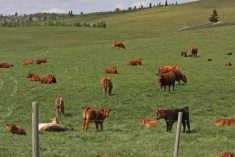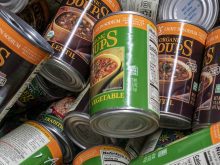In the middle of February my daughter, Katherine and I took a few days
and went to British Columbia to check out some schools she is
considering for next year.
I had been apprehensive about driving through the mountains in February
but the drive to B.C. was beautiful, with sunshine and dry pavement all
the way.
But as often happens, the spring weather changed. On the way back the
roads were terrible with slush, gravel, ice and packed snow that got
Read Also

Fuel rebate rule change will affect taxes and AgriStability
The federal government recently announced updates to the fuel rebates that farmers have been receiving since 2019-20.
worse as we drove. Between Salmon Arm and Revelstoke, the snow was
falling thicker and the accumulation along the side of the road made it
difficult to leave the main flow of traffic.
We continued to Revelstoke where we were able to get off the highway
and find a hotel room. We were up early the next morning and ready to
go when we were informed that the highway was closed because of the
snow and avalanche danger.
Like many others we headed to the restaurant. It was easy to spot the
stranded travellers. A few appeared frantic and frustrated. One man was
working on his laptop and preparing information to fax to his office.
Another walked into the restaurant with a paperback book under his arm
ready for a leisurely meal and wait. Two boys played with a building
toy at the table while they and their mother waited for the bus.
By 3 p.m. the pass was open and traffic started to move. Again I was
concerned about the mountain driving, the drivers in a rush to make up
time and, now, the snowy roads. We said a prayer and headed out. The
drivers were all courteous and careful and a sense of camaraderie
developed when at one point the traffic came to a standstill and some
drivers got out to walk up the line of traffic to see what the problem
was. They shared what they learned with the other drivers as they
walked back to their vehicle. Eventually we arrived safely in Canmore,
Alta., and shovelled our way to our motel room.
We dearly hoped that the 45 centimetres of wet snow would also be
falling at home in Saskatchewan but unfortunately we ran out of the
snow about 50 kilometres east of Calgary and we had dry pavement the
rest of the way home.
Snake problems
A reader from southern Saskatchewan called to say that she had a
problem with snakes in her home and was looking for advice about how to
get rid of them.
I spoke with Scott Hartley, Saskatchewan Agriculture’s pest management
specialist in Regina. We assumed that the reptiles she was dealing with
were harmless garter snakes. All snakes are beneficial to farmers
because they consume a large number of pests such as insects, rats and
mice. But when they seek to den up in people’s houses, their appeal
lessens.
Hartley suggested some ways to remove snakes. One way is to put wet
cloths on the floor near where the snake is thought to be and cover
with dry cloths or burlap bags. Snakes tend to crawl under or between
the cloths for moisture and shelter and can then be removed by hand. A
more successful alternative that uses the snake’s desire to warm itself
is to put a board on the floor, turn a metal bucket upside down and
then suspend a light bulb inside. Wedge the pail up about an inch so
the snake can get into the warm area.
Once the snake is under the pail, remove the wedge to lower the pail,
disconnect the light and, using the board, turn the pail right side up.
Now you can easily transport the snake to a new location away from
people.
Another option is a snake trap or glue board placed next to the wall
where a snake may travel. When it goes into the box it becomes stuck in
the glue. The box can be easily picked up and disposed of, or the snake
can be released outside by pouring vegetable oil over it to release it
from the glue. Traps and glue boards are available at most farm
hardware stores.
The best solution to a snake problem is to remove potential habitat
near buildings and seal up the building. The removal of brush, brush
piles, dried leaves in a hedge, stone piles, woodpiles, tall grass and
other favourable cover will discourage snakes from living in an area.
In the spring and fall inspect your home, other buildings, wells and
cisterns for cracks and holes. Soil that has moved away from the
foundation due to dry weather should be replaced with a clay soil and
then well packed next to the foundation.
For small holes and cracks, silicone sealant is recommended. For larger
holes spray foam can be used or steel wool or a copper mesh that
doesn’t rust can be stuffed into the holes and then siliconed over. For
brick homes that have weep holes between the lower bricks, a company
from Tennessee sells weep hole vent covers and a snake repellent to
keep out the pests. They can be ordered from www.
critterridders.com, customer service 901-365-BUGS, fax: 901-365-3955.
Quick tips
A friend was over and while helping do dishes she washed and towel
dried a plastic bag and then popped it over a glass on the counter to
dry. I believe in reusing plastic bags but I hate seeing drying bags
all over. A tip I received years ago and have used ever since is to
wash the plastic bag, shake out the water and then pop it into the
freezer. When you want to use a bag, take it out and shake the ice
crystals into the sink.
Send us your quick tips and we will share them with our readers. Here
are more tips.
- Chop up several onions and then put in a Ziplock bag and freeze. When
you need chopped onion in a recipe there is no mess or tears.
- To prevent rust and yellow stains in the dishwasher add one to two
tablespoons of rust remover to the washer along with a regular load of
dishes and detergent. Wash as normal. Don’t use when washing china.
- If you have yellow rust stains in your dishwasher, open a package of
Tang drink crystals and empty inside the dishwasher. Run a wash cycle
without dishes.
Betty Ann Deobald is a home economist from Rosetown, Sask., and one of
four columnists comprising Team Resources. Send correspondence in care
of this newspaper, Box 2500, Saskatoon, Sask., S7K 2C4.














